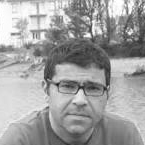Some of the world’s leading companies with unique production plants worldwide, some still excellent research despite many obstacles (investments in R&D is merely over 1.3% of GDP), the ability to build locally-integrated value supply chains. These are the elements that mainly characterize the bioeconomy in Italy, making the country a recognized point of reference. Last but not least, last 22nd November a national strategy (“The bioeconomy in Italy: a unique opportunity to connect the environment, the economy and society”) was introduced, providing a stable and consistent framework for this sector. In a country where in 2016 GDP only grew by 1% and where the employment rate is stuck at 57.3%, the development of a new economy based on the use of biological resources represents a great opportunity for a new industrial Renaissance.
The National Strategy
Italy aims for a leading role in the Euro-Mediterranean scenario, with a very challenging objective: to go from the current €250 billion turnover and from 1.7 million employees of this metasector – as estimated by an analysis by Intesa Sanpaolo Direzione Studi – to €300 billion and over 2 million employees by 2030.
The strategy is the result of teamwork, involving the Ministry for the Economic Development and the Ministry of Agricultural, Food and Forestry Policies, the Ministry of Education, University and Research, the Ministry of the Environment and Protection of Land and Sea, the Conference of Regions and Autonomous Provinces, the Agency of Territorial Cohesion, the National Technological Clusters of Green Chemistry (SPRING) and of Agrifood (CLAN).
“The strategy’s aim is to offer a shared vision of economic, social and environmental opportunities and related challenges to the implementation of a locally deep-rooted Italian bioeconomy. Moreover, it represents an important opportunity for Italy to strengthen its role in promoting sustainable growth in Europe and in the Mediterranean basin.” In addition: “The bioeconomy could considerably contribute to regeneration, sustainable economic development and political stability in the area and thus to the reduction of migration phenomena (for instance with the accomplishment of local investment projects with a high social and infrastructural impact, as expressed in the ‘Migration Compact’ paper proposed by the Italian government).”
Then a few implementation tools are defined: supporting policies regarding demand such as standardization, labelling and public procurements. “The lifecycle approach and eco-planning should guide the transition, so as to find the right balance between fossil-based and bio-based products, in particular in sectors where environmental concerns are higher, thus encouraging the use of solutions with a low environmental impact which are already available.”
Not only that: the strategy intends to promote the right communication and information to consumers “in order to increase the level of knowledge of bio-based products, highlighting their positive impacts in social and environmental terms (green jobs, social acceptance, lower greenhouse gases, reduced extraction rate of non renewable resources, benefits for the Earth and ecosystems and conservation of biodiversity), aimed at increasing private demand.”
It also encourages the need to create a market for the bioeconomy products, thus favouring matching demand and supply of biomass, technology and services.
Novamont and the Intuition of Integrating Chemistry and Agriculture
The strategy came only in late 2016, but the Italian bioeconomy has a much longer history. It dates back to 1989 when within the Montedison School of Materials Science – Italy’s main chemical company – Fertec was created, a centre for strategic research whose aim was to integrate chemistry and agriculture. The intuition to integrate chemistry and agriculture – forming the first unit of Italian green chemistry is ascribable to Raul Gardini, who at the time was Chief Executive of the Ferruzzi Group which since 1987 had become the majority shareholder of Montedison and whose main activity – up until then – had been in the agribusiness, in particular in the agricultural raw material market.
A lot of water has flowed under the bridge since then but if nowadays Italy can boast a leading role in the field of the European bioeconomy it is all down to the first steps taken by the green chemistry within the Mondedison Group, where Catia Bastioli, Novamont’s CEO, was also emerging. From Fertec research centre she built what has become the world’s leading company in the development and production of bioplastics and biochemicals, through the integration of chemistry, the environment and agriculture.
With 600 people, the Novara-based company, closed 2015 with a €170 million turnover and constant investments in R&D (6.4% of 2015 turnover, 20% of dedicated people), with a portfolio of approximately one thousand patents.
Italy’s leadership built at the beginning of the Third Millennium has not depended exclusively on Novamont.
Mossi Ghisolfi, ENI-Versalis and GFBiochemicals are now amongst the main protagonists of the global bioeconomy, with the world’s top plants for the production of new biobased chemical products. We cannot forget Guido Ghisolfi, Gruppo Mossi Ghisolfi’s Vice-President and Biochemtex CEO, who died prematurely in 2015. Thanks to him, Italy’s first producer, and third at global level, of PET (polyethylene terephthalate, commonly used for mineral water bottles) made its debut into this sector and now it is ranking third worldwide in the field of chemistry from renewable sources. Guido Ghisolfi was a visionary and was convinced that the green sector was one of the leading industries of the economy, one of the fields where to invest to allow Italy’s economy to pick up again.
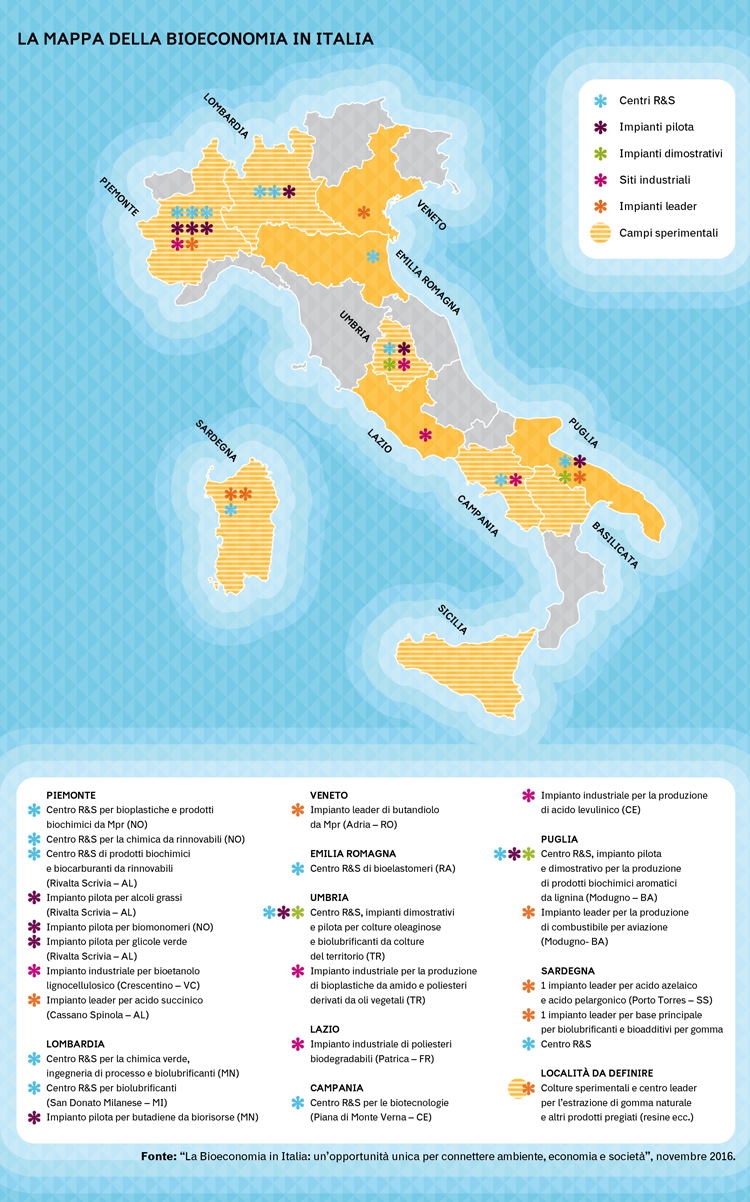
The World’s First Biorefinery for Second-Generation Bioethanol
“America is in Crescentino,” he had proudly declared on October 9th 2013 at the inauguration of the Crescentino biorefinery for second-generation bioethanol, the first of its kind in the world.
Owned by Beta Renewables – a joint venture between Biochemtex, an engineering company of Mossi Ghisolfi group, the America fund TPG (Texas Pacific Group) and the world’s leader in biotechnologies, the Danish Novozymes – the Crescentino facility is the result of a €150 million investment, which focuses on green chemistry and has led Italy to the technological forefront worldwide, in a strategic industrial sector.
The plant is completely self-sufficient with regard to energy consumption (13 MWh of power generated using lignin) and does not produce effluents from industrial production, thus guaranteeing 100% water recycling.
The revolutionary “aspect” of the biorefinery lies in the technological platform used to obtain bioethanol. The innovative PROESA (Ethanol production from biomass) technology combined with Cellic enzymes produced by Novazymes does not use sugars present in lignocellulosic biomasses to obtain alcohol, fuels and other chemical products, with lower emissions and at competitive costs compared to fossil fuels.
Moreover, PROESA, which in 2012 was awarded the Achema prize as the most innovative biotechnology, produces biofuels guaranteeing greenhouse gas emissions reduced by almost 90% compared to the use of fossil-based fuels. And not just biofuels, since Biochemtex boasts partnerships for the production of biochemicals with Amyris, Codexis, Genomatica and Gevo.
The Matrìca Model in Sardinia
Italy has also the first plant in the world for the production of azelaic acid and pelargonic acid using raw materials from oilseed crops and vegetable waste. That’s the Matrìca biorefinery – the equal joint venture set up by Versalis, ENI’s chemical division and Novamont – which is the result of the conversion of the petrochemical plant in Porto Torres (Sardinia) into a facility for the development of an innovative range of products (bioplastics, biolubricants, plant protection products, additives for the rubber and plastic industries, home and personal care products) with an integrated agricultural supply chain. Indeed, in Sardinia Matrìca signed a sector agreement with Coldiretti for the use of thistle, low input dry farming suitable for the Mediterranean climate which is grown on abandoned soils and all its components are usable. By pressing seeds, you can obtain oil – the raw material that feeds the biorefinery – a protein meal that can replace the soy that is currently imported to feed animals and numerous molecules with very high antioxidant properties. Vegetable waste deriving from transformation is also used to meet the energy needs of the whole industrial process and may be used as raw material for new initiatives now being experimented.
Mater Biotech in the Veneto Region for Biobutanediol
The model of biorefinery integrated into the territory is replicated by Novamont through its subsidiary Mater Biotech, in Bottrighe di Adria in the Veneto region, where last 30th September the world’s first industrial plant for the production of butanediol from biomass was inaugurated.
With an investment of over €100 million, the Mater-Biotech biorefinery, also born out of the reconversion of a dismantled industrial site, as of 2017 it will produce 30,000 tonnes of butanediol a year, with low environmental impact, with over 50% saving of CO2 emissions.
Butanediol (1.4 Bdo) is a chemical intermediate obtained from fossil fuels (the main world’s producer is BASF), which is vastly used both as solvent and to produce plastics, elastic fibres and polyurethanes. It has a market value of approximately 1.5 tonnes, the equivalent of €3.5 billion, which – it is estimated – in 2020 it will reach 2.7 million tonnes with a value of over €6.5 billion.
Novamont, starting from a technology developed by Genomatica – a leading Californian company in the bioengineering sector – set up a biotechnological platform to obtain biobutanediol starting from sugars through the action of aptly-engineered Escherichia-coli type bacteria.
“Mater-Biotech – according to Catia Bastioli – is an element of plant systems unique in the world and interconnected which we must consider as a formidable accelerator, as a multiplier of opportunities in the bioplastic and chemical supply chain, for those producing raw materials, end products, for new entrepreneurial ideas, for the creation of new jobs, for those interested in planning a more environmentally and socially-sustainable future.”
The Green Refinery Project in Sicily and Levulinic Acid in Campania
From North to South: in Sicily the bioeconomy is linked to green chemistry reconversion of the ENI refinery in Gela, expected to invest €2.2 billion in the four-year period between 2014-2017 in the industrial area. Once the reconversion is completed, the Gela green refinery will deal with the treatment of palm oil refined for the production of energy and it will also use food waste products, animal fats and exhausted frying oils.
While in Campania, in the Caserta area, the first plant in the world producing biomass-derived acid is now operational. Owned by GFBiochemicals, the plant aims at achieving in 2017 a 10,000 tonnes production and a 50,000 one by 2019. But more importantly, the company believes it will be able to market biolevulinic acid at a low price in a few years compared to the equivalent oil-based product with the same performance.
SMEs and Start-ups
And there is more to the Italian bioeconomy than large multinational companies. Over the years, a number of small enterprises have been set up, often university spin offs, which have managed to carve out a niche for themselves, which made them protagonists worldwide.
One such example is Bio-on, a Bologna-based company that with over 50 patents registered in the last nine years is now amongst the leaders in the technologies for ecosustainable chemistry and in the industrial development of PHAs production (polyhydroxyalkanoates), bioplastics that can replace numerous traditional polymers, obtained with hydrocarbon-based petrochemical processes.
PHAs bioplastics developed by Bio-on are produced from renewable vegetable sources (for example the residues of beet and cane sugar production) with no competition with the food sector; they are entirely ecosustainable and biodegradable. Born as a technology provider, the Bologna-based company has just announced that it will start producing directly special biopolymers in a new plant of 1,000 tonnes a year, which will be completed by 2017 with an investment of €15 million. The objective is to produce by 2020 a €140 million turnover with a cash flow of over 60 million.
Pursuit of Excellence
Behind Italian companies’ success lies research in laboratories and universities. ENEA – the national agency for new technologies, energy and sustainable economic development – is one of the centres of excellence.
Trisaia – a Basilicata-based research centre – is the pride and joy of Italian public research in green chemistry, recognized at international level, mainly for the use of biomasses as energy sources in the field of power and heat generation in small-sized plants (local agro-energy supply chains) and in that of second generation biofuels. Here, several pilot plants have been built that are used in research projects or supporting the industry in the sector, such as Mossi Ghisolfi. And in Rotondella, the Canadian Comet Biorefining is also testing its own technology.
While the activities of technological research and development in power generation and biofuels from microalgae crops and other photosynthetic microorganisms are carried out in the laboratory of microalgae technologies of the Casaccia Research Centre, near Rome.
“The bioeconomy in Italy: a unique opportunity to connect the environment, the economy and society,” tinyurl.com/gt9tty6
Bio-on, www.bio-on.it/?lin=inglese
Top Image: Painter from central Italy La città ideale (“The ideal city”) 1490, details.National Galery of The Marche. Palazzo Ducale, Urbino, Sala degli Angeli – ©WikiCommons, Public Domain
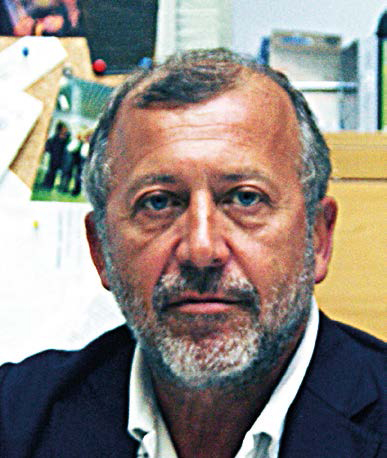
Interview with Giovanni Sannia, Director of BioCirce Master’s
Edited by M. B.
The First Master’s in Bioeconomy and Circular Economy
The first edition of the university Master’s Degree in Bioeconomy and the Circular Economy was inaugurated last 23rd January. This is a two-fold novelty because not only this Master’s is the first in Europe devoted to an in-depth analysis of the bioeconomy and the circular economy, but also because, for the first time, four major Italian universities have joined forces: University of Turin, University of Milano Bicocca, University of Bologna and University of Naples Federico II. The industrial support was offered by three important players in this sector – Novamont, GFBiochemicals and Lodi’s Scientific Park – together with Intesa Sanpaolo bank group, sole global financial partner of the Ellen McArthur Foundation.
Renewable Matter interviewed Giovanni Sannia, professor of molecular biology at University Federico II and Master’s director.
What led four Italian universities to organize the first European Master’s in bioeconomy and circular economy?
“The development of an economy that grows respecting the environment and reducing its reliance on resources such as fossil fuels appears the key objective of Europe’s and the world’s policies where to concentrate resources in research and development in education. The four universities that have collaborated in the planning of the Master’s are sites of excellence for the research in the industrial biotechnologies sector in Italy. Those academic environments also provide education for industrial biotechnologists, which are the future backbone of the industrial sector of biotechnologies.”
What professional roles are you planning to create with your Master’s?
“BioCirce offers a highly advanced curriculum for the education in the sectors of the economy based on a responsible and sustainable use of biological resources and biotechnological processes. The programme will create professional figures able to interact on all aspects of production and marketing of biobased products and processes, with particular attention to those processes and products with the highest innovative potential.”
What role do Novamont, GFBiochemicals, Lodi’s Scientific Park and Intesa San Paolo banking group play?
“Non-academic roles are not merely ‘showcases’ but they are fundamental for the education and identification and creation of professional figures able to meet the needs of the industrial sector as best as they can. The idea was to start an on-demand curriculum according to such needs. So far the collaboration of non-academic partners involved the identification of a representative of the Master’s coordinating organ, teachers selected in the various sectors in order to add more variety to the teachings, the possibility given to students to accomplish internships.”
In your opinion what are the strengths and weaknesses of the Italian research in the bioeconomy?
“Without a doubt the number one strength is the ability of all players to work as a team overcoming the tendency to self-referentiality while appreciating the added value provided by collaboration. The set up of green chemistry Cluster SPRING is a good case in point. In just a little over two years it managed to become an increasingly strategic entity in the biobased sector in Italy and a key player in the growth of the bioeconomy.”
What is your opinion on the Italian strategy for the bioeconomy?
“Although it has arrived a little late, the strategy represents a fundamental element for direction and planning at national level which also allows us to align planning and national priorities with the European ones. A tool thanks to which Italy is now a strong and compact interlocutor in the European context.”
BioCirce, masterbiocirce.com
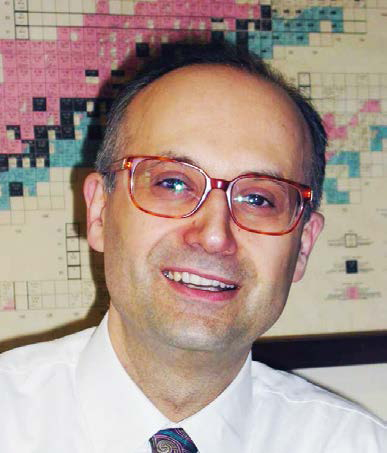 Interview with Fabio Fava, scientific coordinator of the Italian strategy on the bioeconomy
Interview with Fabio Fava, scientific coordinator of the Italian strategy on the bioeconomy
Edited by M. B.
The Italian Strategy: Focusing on Innovation and Interconnection
Fabio Fava is professor and researcher of industrial and environmental biotechnologies at the School of Engineering at Bologna University. He is Vice-President of the department of Environmental Biotechnology of the European Federation of Biotechnology and a member of the Working Party on Bio-, Nano- and Converging Tech of the OECD and of Expert Group on Biobased products at the European Commission. He is also the scientific coordinator of the Italian strategy on the bioeconomy, presented last November. Renewable Matter encouraged him to expand on this new strategy.
What are the main pillars of the Italian strategy for the bioeconomy?
“Basically two: the first is research and innovation to increase productivity but also the quality of products and sustainability of every sector making up the bioeconomy. The second is the interconnection of sectors, in particular amongst those of the agro-food industry and those of chemical and energy valorisation of residual and lignocellulosic biomasses. In Italy there are well over 3 million hectares of land that are no longer farmed, vast agricultural areas that today can be regenerated to produce local biomass and/or industrial one to feed our biorefineries.
“Not only that: every year, in Italy 15 million tonnes of by-products and waste from the food industry are generated: a huge problem for the industry producing it, a very interesting feedstock for our biorefineries. Other relevant opportunities can derive from more substantial integration between biorefineries and thus the production of biobased chemicals, biomaterials and bioenergy and the forestry sector which today boasts a wealth of wood biomass guaranteed by over 13 million hectares of woodland, on average not very much used. But also from chemical and energy valorisation of non-food biomasses (algae, posidonia but also microorganism) generated by our seas. The bioeconomy offers us an unmissable opportunity to make the most of the biodiversity at our disposal, biomass in all its forms, as well as of the residues and organic waste.
“In this respect, the strategy must be seen as the starting point for a more direct political action, with investments, better coordination between central and regional level, the creation of a market also through the right education and information of public opinion. Some incentives would also be useful, to mitigate the costs of biological products which are higher than traditional products, aimed at getting in line with Europe.”
So the ball is now in the Gentiloni government’s court.
“Of course. The first thing I believe will happen is that the strategy will be adopted by ministries and regions that actively collaborated to its creation. It is a very important stage to make sure the various institutions can help support and implement priorities by integrating their actions, resources and infrastructure, while reducing fragmentation and duplication. To this end, it is imperative that there is coordination at national level so that the implementation of the strategy is monitored as well as its promotion at European and international level.”
In what way must these strategies interconnect amongst them and with the national strategy?
“It is good to include regional strategies to the national one. The strategies of Regions must be more specific and become systematic, in order to avoid over fragmentation and the right value of their complementarity. I’ll give you an example: Tuscany has 160,000 hectares of land that is no longer utilized, but it has no biorefineries. Umbria has the oldest biorefinery in Italy, but it has not got the necessary biomass. They are two neighbouring regions: it is pretty clear that a Tuscany’s smart strategy must include a synergy with Umbria and vice versa.”
How do you see the Italian bioeconomy in the European context? And, more importantly, in the Mediterranean one?
“The Italian bioeconomy is ranking third in Europe for employment and turnover and Italy is also in third place as winning country of R&I projects in the sector of the bioeconomy within Horizon2020 and BBI JU. So, Italy is already a leading country. Such leadership can only increase if we will be able to systematise our competences, know-how and infrastructure while enhancing our biodiversity and resources. We are in a good position to maintain our strong position, but also to grow. In this respect, the national strategy will play an important role also in consolidating the leading role of Italy in the Mediterranean where we lead two important initiatives: the BlueMed initiative aimed at promoting integrated and sustainable exploitation of resources of the Mediterranean and to support the agribusiness in the Mediterranean countries of Europe and Northern Africa. The bioeconomy represents a real opportunity to bring environmental regeneration, food and work, so equity and social cohesion, all over the Mediterranean.”
In this area, can the development of the bioeconomy – as the strategy claims – contribute to solving the migration problem?
“Bringing more food, work and value to abandoned rural or degraded areas as well as to the wealthy forest and marine resources of the area means improving the living standards of local people and thus of social cohesion. So, it also contributes to solving some of the reasons pushing people to migrate. This clearly is not enough, but is a first and inescapable step: in this regard, environmental sustainability goes hand in hand with the social one.\"
The concept of the bioeconomy is still unknown to the Italian public opinion. But without public support it is difficult to find support for decarbonisation policies. What needs doing to communicate effectively what the bioeconomy is and what its advantages are?
“Not only is the bioeconomy not very well known by the general public, I believe, but there is also some ignorance at scientific and political level. There is a need for communication professionals able to use a shared language, starting from schools, letting everybody know that we are not talking about a niche. But it is also important that the industrial and scientific worlds be involved, working in fairs, initiatives open to the public where things can be explained. Through an involvement of the traditional press and the new social media. There is really a lot to do.”
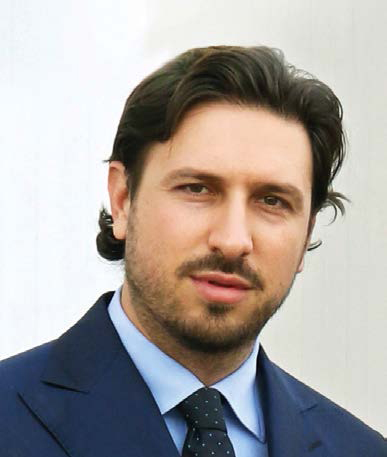 Interview with Pasquale Granata, co-founder of GFBiochemicals
Interview with Pasquale Granata, co-founder of GFBiochemicals
Edited by M. B.
The Future of Chemistry is Biobased
Born in Caserta, a Bocconi University graduate, Pasquale Granata is the founder, together with Mathieu Flamini, of GFBiochemicals. The initial G of the company’s name stands for Granata, while the F stands for Flamini: but the two letters together are also an acronym of green future. The two young entrepreneurs, starting from the Caserta plant, the first in the world to produce biomass-derived levulinic acid, are strongly committed to achieving this “green future.”
Over the last few years GFBiochemicals established itself as one of the most dynamic companies in the biomass-derived chemistry panorama: first the start of the commercial plant in Caserta and then Segetis acquisition in the USA. What are your development plans?
“At GFBiochemicals we believe that the future of chemistry is biobased and that levulinic acid is the next big chemical platform. All that will be prompted by the need to tackle climate change and reduce greenhouse gas emissions and our dependence on fossil-derived raw materials. Oil reserves are limited, the question is to understand when we will be forced to break free from oil. Rather than waiting around, we prefer to be pioneers of the emerging bioeconomy, bringing new biobased solutions such as levulinic acid and by-products into the market. In 2017 we aim at achieving in our Caserta plant a 10,000 tonne production. And we would like to reproduce the Caserta plant in other parts of the world, through strategic partnerships.”
In Italy the bioeconomy developed in the absence of a national strategy, which came last November. What do you make of it?
“I reckon it is an absolutely positive move. Having a national strategy is key, because there is a need for a solid and consistent framework promoting research and innovation. Moreover, thanks to the strategy Italy will gain importance in Europe. Italy has all it takes to become a European leader. It is fundamental, though, that the excellence that it boasts today is included in a medium to long term vision of the government.”
What steps do you think the government will have to take to encourage the development of the bioeconomy?
“A detailed action plan will have to be set up. I believe that three measures will have to be taken: the first is about the creation of a new market; the second is the support to the demand through green public procurement policies based on a clear standard and labelling system; the third is communication and popularization of the bioeconomy so that consumers and public opinion know that we are not talking about a niche, but about a sector that is already creating wealth and employment.”
You are still amongst the founding members of the first European Master’s in Bioeconomy and the Circular Economy. How important is the relation between industry and university to promote innovation in the green chemistry?
“It is fundamental. We strongly believe in this Master’s, because we think it is essential to train managers with multidisciplinary knowledge, able to manage complex issues in multinational contexts. The innovating industry is based on research and development. Against this backdrop, the relations with academia must be strengthened, starting from enhanced efficiency in the offices for the technological transfer of universities.
“Italy is a country with a 40% youth unemployment rate and many graduates find jobs in line with their expectations only abroad. We are an Italian enterprise, willing to maintain strong links with its territory. And this means collaborating more closely with our universities, as we have done with BioCirce Master’s.”
GFBiochemicals, www.gfbiochemicals.com/company
 Interview with Ezio Veggia, Confagricoltura’s Vice-President
Interview with Ezio Veggia, Confagricoltura’s Vice-President
Edited by M. B.
“Not only Biorefineries and Bioindustry”
An excessive focus on the bioindustry and biorefineries. This is what Confagricoltura (Confederation of Italian farmers) criticizes about the Italian strategy on the bioeconomy. The confederation represents over 45% of the value of the saleable agricultural and forestry gross production (overall more than €47 billion) and its added value (€27 billion) covers about 38.5% (5 million hectares) of the utilized agricultural land in Italy. Renewable Matter interviewed Ezio Veggia, Confagricoltura’s Vice-President.
What is Confagricoltura’s opinion on the strategy for the bioeconomy?
“As an association representing companies in the agricultural sector we would like to point out that the document – although a good starting point – should be improved in order to fully represent the complexity and the opportunities of the Italian bioeconomy.”
What is the main criticism?
“Altogether, the agricultural, forestry, fishing and agribusiness sectors represent over 60% of the value of the Italian bioeconomy. However, in our opinion, the document shows a strategy overly focussed on the bioindustry and biorefineries.
“To organize the supply chain in the best possible way we believe it is necessary to promote the use of agricultural residue deriving from the first harvesting and from by-products for other economic activities. In this way farms become more competitive and employment in rural areas is consolidated and improved.”
In Italy there is a lot of talk about marginal lands. Are they a viable option?
“There is no such thing as marginal lands, but lands on which not all necessary conditions for a sustainable development can be met. Above all – above all on large hilly or mountainous areas in particular in the South of the country – the principle of economic sustainability is not met. As a result, these lands are progressively abandoned with serious damage from an environmental and hydrogeological instability point of view.
“Today, with the opportunities offered by the bioeconomy, this trend can – or rather must – be reverted. The Italian and European agricultural policy must take a step forward and in addition to backing and enhancing the existing instruments such as CAP and RDPs, used as levers to implement a radical transformation towards an agricultural model aiming for intensifying production in a sustainable way.
“This is why the amendments proposals to the consultation document put forward by Confagricoltura are aimed at a wider role – including marginal lands – of the agricultural and forestry sector in the bioeconomy. With particular reference to bioenergies (biofuels, electricity and heat energy), from neutraceutics and biocosmetics to the production of organic soil improvers.”
What else is needed to achieve the full potential of the Italian bioeconomy?
“We wish that the paper highlights the important role played by the agricultural business along the whole supply chain that, not limiting itself to just producing biomasses is increasingly oriented toward the following transformation into new products (food, fertilizers, energy, bioproducts, for example).
“A model of agricultural production in line with the principles of the bioeconomy and the circular economy towards which the European Union is headed, since farms can produce for the food sector and also recover waste within the same cycle, as highlighted by the energy supply chains of biogas-biomethane.”
In what way can biorefineries integrated at local level – peculiar to the Italian model – act as a lever for rural development?
“A very interesting example can be found in the energy supply chains of biogas-biomethane within which the anaerobic digestion systems can be considered biorefineries in their own right.
“Farms, on their own or more often in association with others, using the new model of ‘network contract,’ keep on producing raw materials of great excellence for the food industry. But they use more and more company by-products, manure, chicken droppings and crops from rotations to produce electricity, biofuels and fertilizers. And tomorrow bioplastics and bioproducts for a variety of applications.
“All this can be easily done all over Italy, thus creating new jobs, guaranteeing the presence of man also in marginal areas, making farms totally independent from fossil fuels as far as the consumption of electricity, fuels and fertilizers is concerned.
“This is why we believe that the bioeconomy is the economy of the future. Not only because it is circular, but because it allows to combine technological innovation with local land, farms and food companies and active citizens in the recovering and recycling operations.”
Confagricoltura, www.confagricoltura.it/en
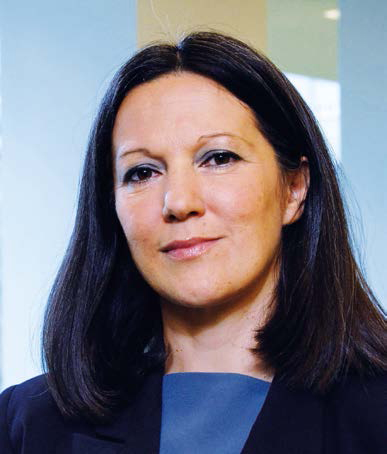 Interview with Catia Bastioli, Novamont CEO
Interview with Catia Bastioli, Novamont CEO
Edited by M. B.
A Paradigm Leap
Catia Bastioli, Novamont’s CEO and president of SPRING, the green chemistry cluster, is a beacon in the Italian bioeconomy. Renewable Matter collected her analysis on the Italian strategy presented by the government. “Italy – according to the CEO of the Novara company – can become a candidate to play an important role for the whole of Mediterranean area.”
At last Italy too is now equipped with a national strategy for the bioeconomy. What’s your take on that?
“Certainly very positive. First of all because this strategy is the result of a multidisciplinary effort involving all the most important institutional players in the field, combining the national plan with that – extremely important – of the regions. They also wanted to consult with national technological Clusters of the green chemistry and Agrifood, bringing together the numerous private and public entities committed to creating a solid bioeconomy in Italy.
“This strategy, in addition to offering a shared vision of the opportunities and challenges linked to the implementation of an Italian model of the bioeconomy – an original one because it is connected to the peculiar aspect of its territory and production fabric – it represents a key opportunity to find forms of sustainable and inclusive development, able to safeguard the natural capital and at the same time to create new jobs in Italy which can also be replicated in other Mediterranean countries.”
What measures should the government introduce in the very short term to promote full development of the Italian bioeconomy?
“In many cases starting from environmental and social problems troubling us would suffice; defining challenging, measurable, achievable, progressive and respected standards; pushing low cost world’s best solutions and technologies ready to be applied, rewarding synergies amongst the various sectors and integrated supply chains. In Italy there already exist innovative bioeconomy supply chains which, with the right support, could become a formidable accelerator and catalyst of opportunities in several sectors: not a cost of decarbonisation imposed after Paris, but a successful investment for a thorough land regeneration. I am thinking about, for instance, the huge steps forward taken in the treatment and valorisation of organic waste to maximize its collection and transformation into products to improve the quality of soils and to obtain biomethane, chemicals and much more: in such sector it would be possible to pass measures leading Italy to organic zero waste into landfills. Or the maximization of the use of high impact products, starting from the public procurement sector, thus guaranteeing the implementation of existing minimum environmental criteria and quickly defining fresh ones. Let me give you an example: reducing the use of throwaway products in favour of reusable ones, and where this is not possible, supporting the use of biodegradable and compostable plastics in those applications where traditional plastics are polluting organic waste, thus improving opportunities for recycling waste other than organic. Or measures maximizing repercussions on territories starting from what has already been done in sectors of the bioeconomy, such as integrated supply chains of bioplastics and chemicals, with new bioeconomy infrastructure in brownfields, each based on totally innovative technologies in several Italian regions (Piedmont, Umbria, Lazio, Campania, Veneto and Sardinia), with the development of machinery and plants connected to downstream and upstream supply chains, with the recovery of marginal and degraded rural areas through low impact crops, also linked to the production of protein for animal use.
“It is necessary to recognize and give value to all this, but we need to act now, because the highest costs may be those related to inactivity. So much so that Italy is a leader in this sector and other countries are accelerating in the same direction.”
As things stand, what are the strengths and weaknesses of the bioeconomy in Italy?
“The main strength lies not only in having the technologies and know-how, but in having created a shared model, based on the land recovery, from an economic, social and environmental point of view. The Italian bioeconomy focuses not on the quantity of undifferentiated biomass, but on the recognition of quality and diversity, in a circular economy logic and an efficient use of resources. Also, the development of products should not merely aim at replacing the existing ones, but they should contribute to solving real problems of society.
“Even from a legal point of view many steps forward have been taken. However, an overall strategy focussed on the enhancement of natural capital, by adopting high and clear standards, supporting the innovations upgrading land and integrated supply chains is still lacking. Going in this direction with conviction could increase competitiveness in the Italian industry and supply chains and could help us get out of the structural crisis we are in, acting as a driver in other countries as well. Suffice it to see the case study of throwaway bags and the connection with organic waste: Italy has paved the way in Europe, allowing a virtuous growth of green chemistry and organic waste. Now there is a European directive and France not only followed Italy’s example, but boosted it with even higher standards and with positive repercussions for the environment, the economy and jobs. On the subject of legality, respect of quality standards, evaluation of externalities and social costs, there is still much to be done.”
Italy, despite not having a national strategy, has always been a leading country at European level. The strategy specifically refers to the great potential of the bioeconomy for the whole Mediterranean area in terms of economic development, job creation, protection of biodiversity and resolution of migratory problems. What are your thoughts on your latter aspects? What do you really think the role of Italy could be?
“As I said, I am convinced that Italy can become a candidate to carry out an important role for the Mediterranean area, so I can only agree with what stated in the strategy in this regard.
“Here Italy could put its experience and good practice at the service of collaboration projects with a high infrastructural and social impact in the agribusiness, of land recovery, of the fight against water shortages and desertification. As it is well known, the disadvantages hitting soils and the agricultural sector of such countries with a strong rural tradition have important repercussions in both economic and social terms, which in turn are at the base of instability in the area and domestic and international migratory phenomena. This is why the bioeconomy can take on a much wider significance than the use of renewable sources and contribute to sustainable economic development of the area and even to its political stability.”
Novamont is a deeply-rooted company in Italy: it is based in Piedmont, with facilities in Veneto, Sardinia, Umbria and Lazio and a research centre in Campania. How do you think the various regional strategies can best be integrated amongst them and with the national strategy?
“The local character is fundamental for Italy’s bioeconomy, where each region has its own peculiar aspect in terms of natural and agricultural landscape, of biodiversity, of industrial fabric and cultural traditions. The various territories, with their distinctive features, are Italy’s great resources to be enhanced. Long before the national strategy was officially launched, the national Clusters had already taken some important steps to promote dialogue and a debate with all the regions, with a view to harmonizing and integrating strategies and tools to implement them. Amongst the most active regions in the sector of the bioeconomy and the national Cluster of green chemistry, a working group has been operating for a long time with an aim to defining shared and coordinated positions and possible interventions in the field of technological innovation, development strategies and policies, educational activities and incentives to local employment in the field o green jobs. I think this is the direction we should be following.”
Another key theme tackled in the strategy is that of information and dissemination of the bioeconomy, on which the European Commission is also focussing. What needs to be done to engage with public opinion?
“When we talk about the bioeconomy we should think about a true leap of paradigm. We must create the basis of a new culture of sustainable building through the pursuit of collaboration amongst the various interlocutors about local projects that act as workshops in their own right. Communication should talk about real cases that are emerging in Italy, showing the potential for multiplication and interconnection of the various projects, aimed at accelerating the advantageous opportunities for local areas. Creating the conditions for the development of new activities and new models now for widespread uproars both nationally and internationally is a very complex operation. The bioeconomy sector is growing well but it is still very young and fragile: to maximize the possibilities of success in the short term there is a need for common building and meeting ground, away from electoral and media clashes amongst the parties, since it is an opportunity that Italy must take with determination immediately. Indeed, the bioeconomy has the advantage of having clear benefits on people’s quality of life. Let’s think about the impact on the industrial sector or on employment, not just through the reconversion of no longer competitive sites, but also in terms of satellite activities and the revitalization of downstream sectors. Just think of how much could happen in agriculture, with the cultivation of abandoned marginal areas and the creation of new income opportunities in the Italian most troubled areas. Or consider how the consumption habits have changed and how the quality and quantity of organic waste removed from landfills and collected in our big cities has improved thanks also to the sustainable and innovative use of bioplastics, creating a series of precious raw materials instead of costly, smelly and dangerous waste, harmful for our health.”
Novamont, www.novamont.it/eng


